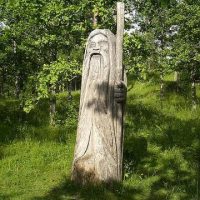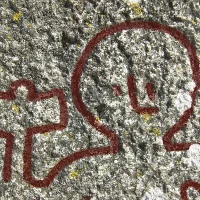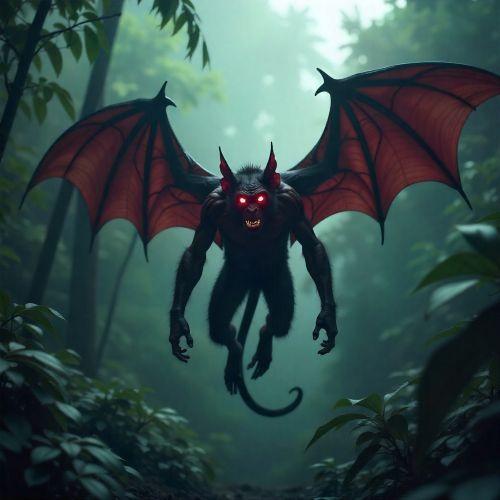Tharapita : The Fiery Sky Deity of Ancient Estonia
Listen
At a glance
| Description | |
|---|---|
| Origin | Estonian Mythology |
| Classification | Gods |
| Family Members | N/A |
| Region | Estonia |
| Associated With | Supreme Powers, Sky, Thunder, Weather, Fire |
Tharapita
Introduction
Tharapita stands as one of the most powerful and enduring deities in Estonian mythology, especially among the Oeselians of Saaremaa. Known by several names—including Taara, Uku, Tooru, and Jumal—Tharapita is portrayed as a sky and thunder god whose authority shaped the religious landscape of ancient Estonia. Medieval records such as the Chronicle of Henry of Livonia describe him as the chief god of the islanders, emphasising his prominence at the time of the Northern Crusades.
The origin myth of Tharapita adds to his legendary stature. According to chronicled tradition, he was born on a sacred hill in Vironia before flying to Saaremaa, marking the island as his chosen domain. Scholars have long debated the symbolic meaning of this flight, with some proposing that it may reflect a cultural memory of the massive meteorite strike that created the Kaali crater. Whether interpreted as a celestial being, a thunder god, or a cosmological protector, Tharapita remains a central figure in Estonia’s mythological heritage.
Physical Traits
Ancient Estonian mythology did not preserve detailed physical descriptions of Tharapita, and much of his characterization rests on his natural and cosmic associations. Instead of being represented as a fully anthropomorphic god, Tharapita is envisioned through elemental forces—thunder, fire, celestial light, and sudden skyward eruptions. His legendary flight across the sky has often been compared to a blazing meteor, which inspired later folkloric and neopagan artistic depictions of him as a towering figure surrounded by storms.
Modern interpretations frequently compare Tharapita to the Norse god Thor or the Finnish Ukko, not because ancient texts explicitly make the connection, but because the similarities in their domains—thunder, sky, and protection—invite such parallels. As a result, contemporary representations tend to imagine him as a powerful sky deity wielding the elemental intensity of lightning and storm clouds.
Family
Estonian mythology generally lacks the extensive divine genealogies found in Greek, Roman, or Norse traditions, and Tharapita is no exception. Most sources portray him as an independent, sovereign deity rather than a member of a complex family structure. However, the names Taara and Uku, often associated with Tharapita, appear in folk traditions linked to sky gods with children or subordinate spirits, such as Kõu (Thunder) and Pikker (Lightning).
These connections reveal cultural overlaps rather than clear familial ties. Since Estonian myth evolved through oral tradition, many characters, titles, and attributes blended over time. This fusion makes Tharapita both a singular deity and a figure whose presence resonates through other thunder and sky-related beings in the region’s folklore.
Other names
The many names associated with Tharapita reveal the linguistic richness and cultural layers of ancient Estonia and its neighbouring regions. Among the most well-known variations is Taara, a name deeply embedded in Estonian folklore and often celebrated in traditional songs. Tooru appears as a dialectal version, possibly shaped by long-standing interaction with Scandinavian cultures. Another important name is Uku, which links Tharapita to the Finnish sky god and reflects shared Uralic mythological roots. In some traditions, he is also referred to as Jumal, a general term for “god” used in sacred and ceremonial contexts. Historical and medieval texts introduce further versions such as Taarapita and Tarapitha, reflecting how the deity’s identity evolved across regions and literary traditions.
The name “Tharapita” itself is frequently interpreted as an ancient invocation, Taara, a(v)ita! meaning “Taara, help!” Some scholars propose an alternative interpretation connecting the name to “Taara’s thunderbolt,” reinforcing the god’s association with thunder, celestial fire, and dramatic sky-bound events. These intertwined naming traditions show how various mythic threads—linguistic, regional, and symbolic—merged to shape the enduring figure of Estonia’s powerful sky deity.
Powers and Abilities
Tharapita’s abilities reflect his role as a sky god, protector, and force of nature. Like other thunder gods in northern Europe, he was believed to command storms, lightning, and celestial fire. His legendary journey from Vironia to Saaremaa suggests the power of flight and fiery descent, often linked to meteor phenomena. The Oeselians revered him as a divine guardian during conflicts, particularly against crusading forces in the 13th century, making him both a spiritual symbol and a cultural rallying point.
His power extended beyond weather control. In some accounts, Tharapita could cleanse lands of idols or false gods, demonstrating both destructive and purifying energy. The association between Tharapita and the Kaali meteorite impact—though speculative—provides a compelling explanation for his portrayal as a sky-born, flame-wreathed deity whose arrival reshaped the land.
Modern Day Influence
Tharapita continues to hold a significant place in Estonia’s cultural imagination. He inspired the 20th-century neopagan movement called Taarausulised or Taaralased, which sought to revive pre-Christian Estonian beliefs. During the Estonian National Awakening in the 1800s, Taara emerged as a symbol of resistance to Germanic and Lutheran cultural dominance, representing a return to indigenous roots.
His legacy appears in place names as well. The city of Tartu is poetically called Taaralinn, meaning “City of Taara,” reflecting the god’s enduring cultural footprint. Historians such as Lennart Meri helped renew interest in Tharapita by suggesting connections between mythology and natural events like the Kaali impact crater.
Today, Tharapita appears in literature, academic studies, neo-folk traditions, and discussions of Uralic mythology. His presence continues to embody Estonia’s search for cultural identity, cosmic wonder, and ancestral memory.
Related Images
Source
Encyclopedia of the Baltic States. (2005). Estonian mythology. Wikipedia. Retrieved November 19, 2025, from https://en.wikipedia.org/wiki/Estonian_mythology
Encyclopedia of the Baltic States. (2005). Tharapita. Wikipedia. Retrieved November 19, 2025, from https://en.wikipedia.org/wiki/Tharapita
Meri, L. (1991). Our Native Land (Estonian National History and Mythology). Tallinn: Eesti Raamat.
Raun, T. U. (2001). Estonia and the Estonians. Hoover Institution Press.
Stronghold Nation. (2012). Tharapita. Retrieved November 19, 2025, from https://www.stronghold-nation.com/history/myth/tharapita
Voices. (2018). Land where everybody has their own fairy. VOICES. Retrieved November 19, 2025, from https://voiceskopje.org/2018/09/12/land-where-everybody-has-their-own-fairy
Viires, A. (1990). Estonian Folk Culture. Tallinn: Eesti Raamat.
Lõugas, V. (1996). Kaali Meteorite Crater and Its Cultural Impact. Estonian Journal of Archaeology, 4(2), 142–150.
Kallas, O. (1924). Estonian Mythology. Helsinki: Suomalainen Tiedeakatemia.
Puhvel, M. (1981). Comparative Mythology. Baltimore: Johns Hopkins University Press.
Frequently Asked Questions
Who is Tharapita in Estonian mythology?
Tharapita is a major Estonian sky and thunder god, worshipped especially by the Oeselians of Saaremaa and mentioned in medieval chronicles as their supreme deity.
Is Tharapita the same as Taara or Uku?
Yes, Taara and Uku are considered alternative names or closely related identities of Tharapita, reflecting variations across regions and traditions.
What event is linked to the Tharapita myth?
Some scholars connect his legendary fiery flight to the Kaali meteorite impact in Saaremaa, which may have inspired cultural memories of a descending sky deity.
Does Tharapita resemble Thor or Ukko?
While not identical, Tharapita shares thunder-god attributes with Thor and Ukko, showing the interconnectedness of northern European mythologies.
Is Tharapita still worshipped today?
Modern pagan groups in Estonia, known as Taaralased or Taarausulised, continue to honour Tharapita as part of revived indigenous traditions.







